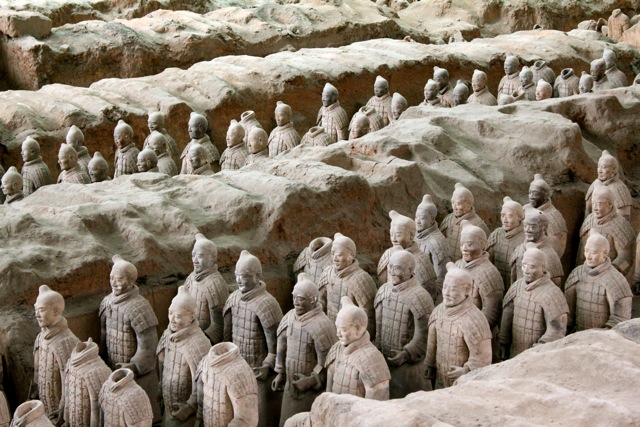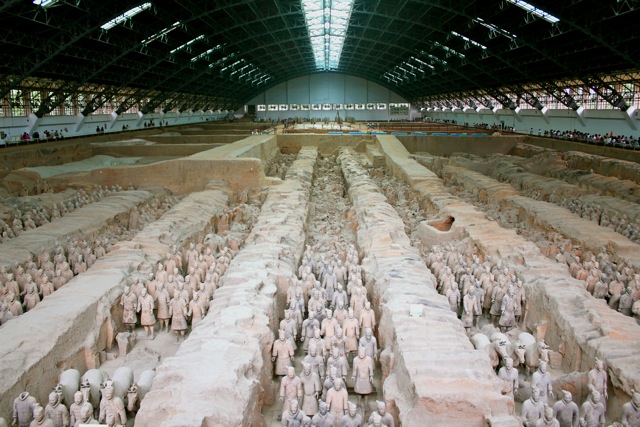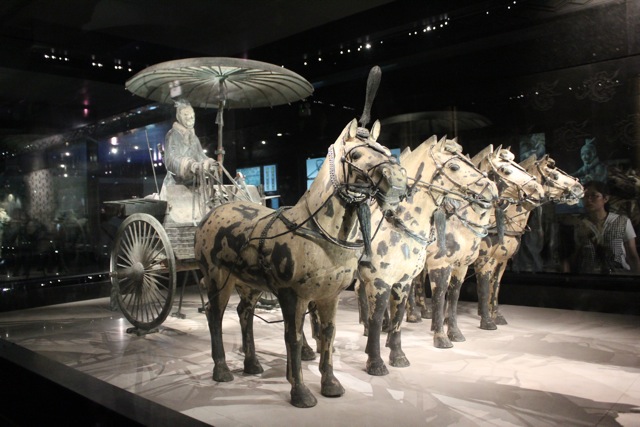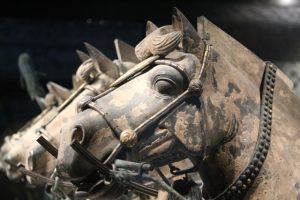
In the spring of 1974, two farmers were drilling a well and came upon one of the greatest discoveries in the last 50 years. At the time, the magnitude of the discovery was unimaginable. But as archeologists continued to uncover what had been hidden for over 1700 years, the scale and craftsmanship of what they found was astounding.
In 221BC, the first emperor of unified China ascended the throne. Emperor Qin Shihuang was only 13 at the time, but controlled power over a vast expanse of land. Within the first year of his rule, the planning began to prepare a site where the Emperor would rest in his afterlife. It consisted of a mausoleum where the Emperor would lay, surrounded by 3 pits of life-sized replicas of his army and attendants. What the Emperor had in his real life would follow him into his afterlife.
The three pits, located 1.5km away from the mausoleum, cover an area of 20,000m2 and contain 7,000 warriors, 100+ wooden chariots and numerous bronze weapons. At the time of construction, everything was meticulously detailed, with the life-like faces, perfectly constructed armour or clothing, and hair so exquisitely crafted you’d be forgiven if you thought it was real. Many of the warriors were discovered with some remnants of colour on them, suggesting that they were actually painted when they were made.
The wooden chariots, with their horses, were made half the size of their living counterparts. They were composed of 3,400 parts and made mainly of bronze with small parts of gold and silver. Today they are considered to be masterpieces in bronze arts.
It is estimated that the project lasted 38 years and used over 700,000 labourers during that time. The discovery of iron torture instruments indicates that the workers were probably criminals and possibly slaves. Workstations, living quarters and graves were also discovered around the mausoleum. Pottery kilns were nearby, indicating most, if not all, of the work was done on site.
In October 1979, the mausoleum was first opened to the public and over the next 30 years the rest of the public sites were built. The three pits are now covered with roofs to protect their relics within. Pit number 1 (the most famous one housing the majority of the Emperor’s army) is at least the size of a football stadium. Visitors can walk the perimeter, enjoying the standing warriors at the front along with the ongoing work of restoration at the back. In addition to the three pits, a museum has been built to showcase the discovery and excavation process of the sites.

About 1.5km and a free shuttle bus ride away, you can visit Emperor Qin Shihuang’s mausoleum. But truth be told, the site is very underwhelming after visiting the Terra-Cotta Warriors, with only a stone plaque marking his grave surrounded by pine trees and hedges.
The entire area (including the mausoleum and pits) covers an astounding area of 56.25km2 with over 600 sites located within. The work and excavation is still ongoing with archeologists believing that not all has been discovered yet. The Chinese have said that the Terra-Cotta Warriors are the “8th Wonder of the World”, and after visiting the site you’d be hard pressed not to believe it.
What You Need to Know: To visit the site on your own, take bus 306 from the Xi’an train station. Buses leave every 10 minutes and stop bringing people back at 7pm. Entrance to see the Terra-Cotta Warriors is 110rmb for adults and 55rmb for students. You can pick up the free shuttle bus to the mausoleum next to the ticket office, through the white queuing gates.


4 thoughts on “The Terra-Cotta Warriors”
Comments are closed.